NCERT Solutions for Class 7 Maths Chapter 1 Large Numbers Around Us
Page No. 2
Q: But how much is one lakh? Observe the pattern and fill in the boxes given below.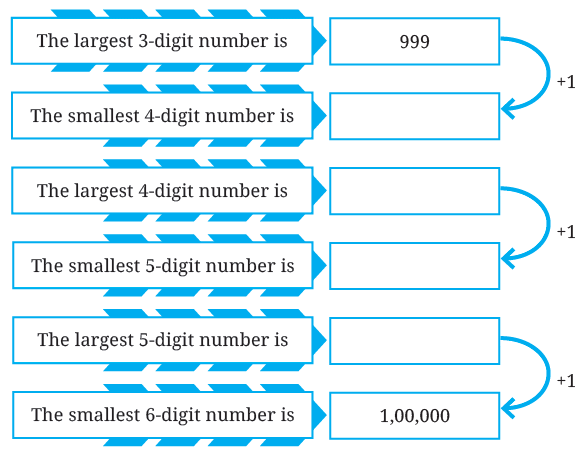
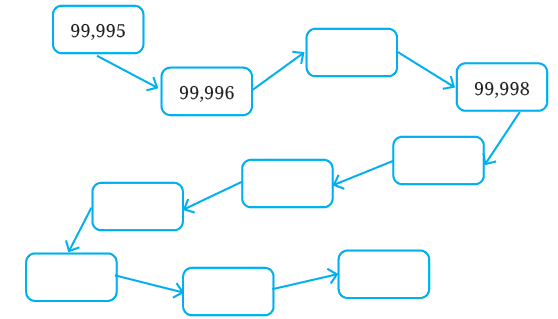
Ans:
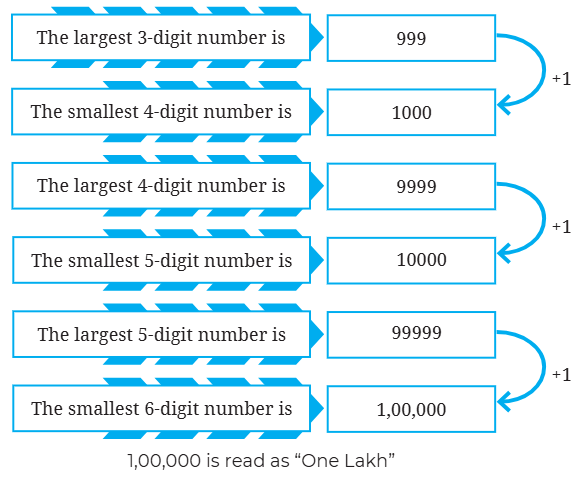
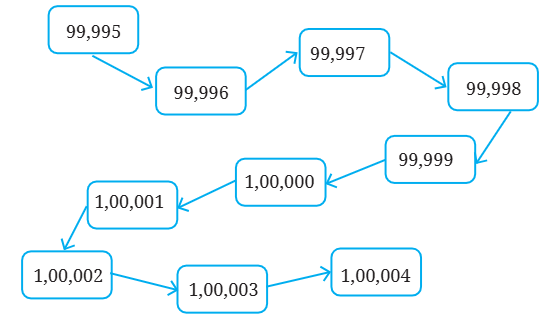
Q1: Roxie suggests, “What if we ate 2 varieties of rice every day? Would we then be able to eat 1 lakh varieties of rice in 100 years?” Will they be able to taste all the lakh varieties in a 100-year lifetime?
Ans: Days in a year = 365
Rice varieties eaten per day = 2
Rice varieties eaten in a year = 2 × 365 = 730
Rice varieties eaten in 100 years = 730 × 100 = 73,000 varieties.
Since 73,000 is less than 1 lakh, we won’t be able to eat 1 lakh varieties of rice in 100 years.
Q2: What if a person ate 3 varieties of rice every day? Will they be able to taste all the lakh varieties in a 100-year lifetime? Find out.
Ans: Days in a year = 365
Rice varieties eaten per day = 3
Rice varieties eaten in a year = 3 × 365 = 1095
Rice varieties eaten in 100 years = 1095 × 100 = 1,09,500 varieties.
Since 1,09,500 is greater than 1 lakh, the person would be able to taste all 1 lakh varieties in a 100-year lifetime.
Q3: Estu said, “We know how many days there are in a year — 365, if we ignore leap years. If we live for y years, the number of days in our lifetime will be 365 × y.”
Choose a number for y. How close to one lakh is the number of days in y years, for the y of your choice?
Ans: Let's assume we live for 95 years, y = 95
Number of days in our lifetime = 365 × 95 = 34,675
Now, difference between 1,00,000 and 34,675 = 1,00,000 − 34,675 = 65,325.
Page No. 3
Figure it Out
Q1: According to the 2011 Census, the population of the town of Chintamani was about 75,000. How much less than one lakh is 75,000?
Ans: One lakh = 1,00,000.
Difference = 1,00,000 - 75,000 = 25,000.
The population is 25,000 less than one lakh.
Q2: The estimated population of Chintamani in the year 2024 is 1,06,000. How much more than one lakh is 1,06,000?
Ans: One lakh = 1,00,000.
Difference = 1,06,000 - 1,00,000 = 6,000.
The population is 6,000 more than one lakh.
Q3: By how much did the population of Chintamani increase from 2011 to 2024?
Ans: Population in 2011 = 75,000. Population in 2024 = 1,06,000.
Increase = 1,06,000 - 75,000 = 31,000.
The population increased by 31,000.
Q: Look at the picture below. Somu is 1 metre tall. If each floor is about four times his height, what is the approximate height of the building?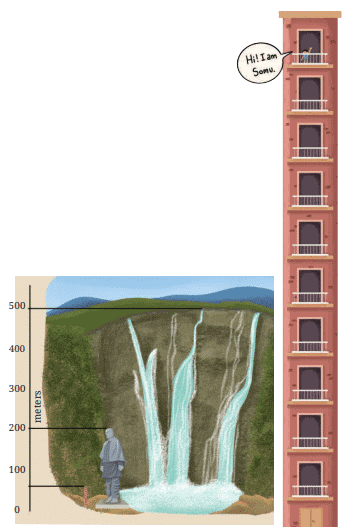
Ans: Each floor is 4 times Somu’s height. Somu’s height = 1 metre.
So, height of 1 floor = 4 × 1 = 4 metres.
The building has about 11 floors (including the ground floor, where a door is shown in the picture).
Height of the building = 4 × 11 = 44 metres.
The approximate height is 44 metres.
Q1: Which is taller — The Statue of Unity or this building? How much taller? ____________m.
Ans: The Statue of Unity is about 180 m
Height of Somu’s building = 44 metres.
The Statue of Unity is taller.
Difference = 180 − 44 = 136 metres.
Q2: How much taller is the Kunchikal waterfall than Somu’s building? ___ m.
Ans: Height of the Kunchikal waterfall = about 450 metres.
Height of Somu’s building = 44 metres.
Difference = 450 − 44 = 406 metres.
Thus, the Kunchikal waterfall is 406 m taller than the building.
Q3: How many floors should Somu’s building have to be as high as the waterfall? ____________ .
Ans: Height of the Kunchikal waterfall = about 450 metres.
Height of 1 floor = 4 metres.
Number of floors = 450 ÷ 4 = 112.5.
Since we can’t have half a floor, it should have about 113 floors.
Page No. 4
Reading and Writing Numbers
Q1: How do you view a lakh — is a lakh big or small?
Ans: A lakh (1,00,000) can be seen as both big and small depending on context. It’s big for things like the number of rice varieties (a lot) or days (274 years). It’s small for things like stadium seating (fits in one stadium), humans have (80,000 to 1,20,000) hairs on their tiny head, or fish laying eggs (1000 + at once). It depends on what you compare it to.
Q2: Write each of the numbers given below in words:
(a) 3,00,600
Ans: Three lakh six hundred.
(b) 5,04,085
Ans: Five lakh four thousand eighty-five.
(c) 27,30,000
Ans: Twenty-seven lakh thirty thousand.
(d) 70,53,138
Ans: Seventy lakh fifty-three thousand one hundred thirty-eight.
Page No. 5 & 6
Q: Write the corresponding number in the Indian place value system for each of the following:
(a) One lakh twenty-three thousand four hundred and fifty-six
Ans: 1,23,456
(b) Four lakh seven thousand seven hundred and four
Ans: 4,07,704
(c) Fifty lakhs five thousand and fifty
Ans: 50,05,050
(d) Ten lakhs two hundred and thirty-five
Ans: 10,00,235
Land of Tens
In the Land of Tens, there are special calculators with special buttons.
Q1: The Thoughtful Thousands only has a +1000 button. How many times should it be pressed to show: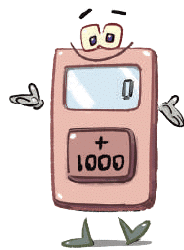 (a) Three thousand?____________?
(a) Three thousand?____________?
Ans: 3,000 ÷ 1,000 = 3 times.
(b) 10,000?____________?
Ans:  times.
times.
(c) Fifty-three thousand?____________?
Ans:  times.
times.
(d) 90,000?____________?
Ans:  times.
times.
(e) One Lakh?____________?
Ans:  times.
times.
(f) ____________? 153 times
Ans: 153 × 1,000 = 1,53,000.
(g) How many thousands are required to make one lakh?
Ans:  thousands.
thousands.
Q2: The Tedious Tens only has a +10 button. How many times should it be pressed to show: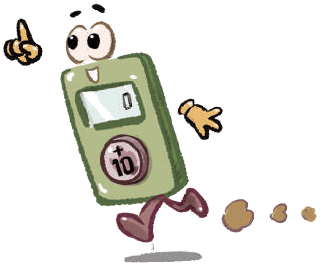
(a) Five hundred?_____________
Ans: 500 ÷ 10 = 50 times.
(b) 780?_____________
Ans: 780 ÷ 10 = 78 times.
(c) 1000?_____________
Ans: 1,000 ÷ 10 = 100 times.
(d) 3700?_____________
Ans: 3,700 ÷ 10 = 370 times.
(e) 10,000?_____________
Ans: 10,000 ÷ 10 = 1,000 times.
(f) One lakh?_____________
Ans: 1,00,000 ÷ 10 = 10,000 times.
(g) _____________? 435 times
Ans: 435 × 10 = 4,350.
Q3: The Handy Hundreds only has a +100 button. How many times should it be pressed to show: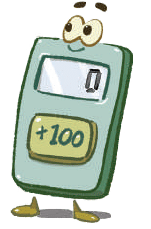
(a) Four hundred? ___________ times
Ans: 400 ÷ 100 = 4 times.
(b) 3,700? ___________
Ans: 3,700 ÷ 100 = 37 times.
(c) 10,000? ___________
Ans: 10,000 ÷ 100 = 100 times.
(d) Fifty-three thousand? ___________
Ans: 53,000 ÷ 100 = 530 times.
(e) 90,000? ___________
Ans: 90,000 ÷ 100 = 900 times.
(f) 97,600? ___________
Ans: 97,600 ÷ 100 = 976 times.
(g) 1,00,000? ___________
Ans: 1,00,000 ÷ 100 = 1,000 times.
(h) ___________? 582 times
Ans: 582 × 100 = 58,200.
(i) How many hundreds are required to make ten thousand?
Ans: 10,000 ÷ 100 = 100 hundreds.
(j) How many hundreds are required to make one lakh?
Ans: 1,00,000 ÷ 100 = 1,000 hundreds.
(k) Handy Hundreds says, “There are some numbers which Tedious Tens and Thoughtful Thousands can’t show but I can.” Is this statement true? Think and explore.
Ans: Yes, the statement is true.
Handy Hundreds can show numbers like 100, 200, 300, etc., by pressing the key once for every 100.
Tedious Tens can also show these numbers, but it needs more presses. For example, to make 100, we need 10 presses of 10.
Thoughtful Thousands cannot show numbers like 100 or 200, because it counts only in multiples of 1000 (like 1000, 2000, 3000...).
So, Handy Hundreds can show some numbers (like 100 or 900) that Thoughtful Thousands cannot, and that Tedious Tens can show but with more effort.
Q4: Creative Chitti is a different kind of calculator. It has the following buttons: +1, +10, +100, +1000, +10000, +100000 and +1000000. It always has multiple ways of doing things. “How so?”, you might ask. To get the number 321, it presses +10 thirty two times and +1 once. Will it get 321? Alternatively, it can press +100 two times and +10 twelve times and +1 once.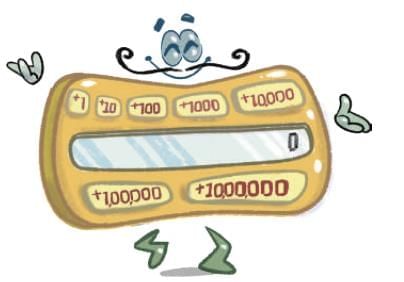 Ans:
Ans:
First method:
Press +10, 32 times
⇒ 32 × 10 = 320
Press +1 once
⇒ 1
Now adding, 320 + 1 = 321
Yes, Chitti reaches 321 this way.
Second method:
Press +100, 2 times
⇒ 2 × 100 = 200
Press +10, 12 times
⇒ 12 × 10 = 120
Press +1 once
⇒ 1
Now adding, 200 + 120 + 1 = 321
Again, Chitti reaches 321.
Q5: Two of the many different ways to get 5072 are shown below:These two ways can be expressed as:
(a) (50 × 100) + (7 × 10) + (2 × 1) = 5072
(b) (3×1000) + (20×100) + (72 ×1) = 5072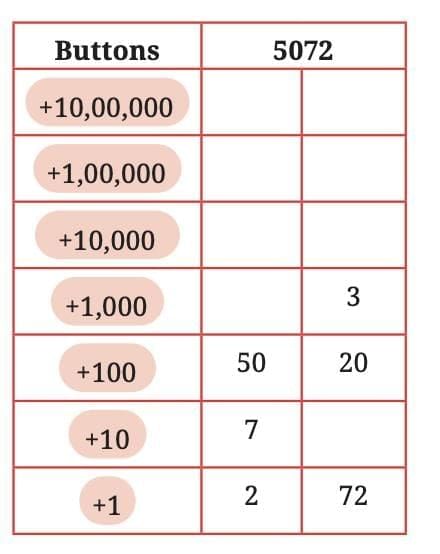
Find a different way to get 5072 and write an expression for the same.
Ans: Here, (5 × 1000) + (0 × 100) + (7 × 10) + (2 × 1)
= 5000 + 0 + 70 + 2
= 5072
To get 5,072, press 5 times + 1,000, 7 times + 10 and then two times + 1.
Figure it Out
Q: For each number given below, write expressions for at least two different ways to obtain the number through button clicks. Think like Chitti and be creative.
(a) 8300
Ans: Way 1: (8 × 1,000) + (3 × 100) = 8,000 + 300 = 8,300.
Way 2: (83 × 100) = 8,300.
(b) 40629
Ans: Way 1: (4 × 10,000) + (6 × 100) + (2 × 10) + (9 × 1) = 40,000 + 600 + 20 + 9 = 40,629.
Way 2: (406 × 100) + (29 × 1) = 40,600 + 29 = 40,629.
(c) 56354
Ans: Way 1: (5 × 10,000) + (6 × 1,000) + (3 × 100) + (5 × 10) + (4 × 1) = 50,000 + 6,000 + 300 + 50 + 4 = 56,354.
Way 2: (563 × 100) + (5 × 10) + (4 × 1) = 56,300 + 50 + 4 = 56,354.
(d) 66666
Ans: Way 1: (6 × 10000) + (66 × 100) + (66 × 1) =66,666
Way 2: (66 × 1000) + (666 × 1) =66,666
(e) 367813
Ans: Way 1: (3 x 100000) + (6 x 10000) + (7 x 1000) + (8 x 100) + 10 + 3 = 3,67,813
Way 2: (367 × 1000) + (813 × 1) = 3,67,813
Page 7
Q1: Creative Chitti has some questions for you: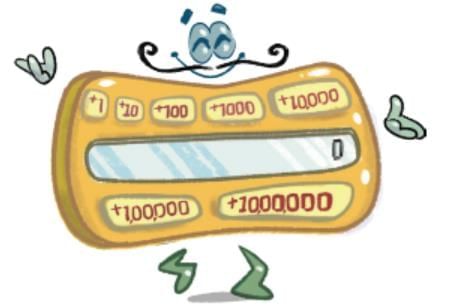
(a) You have to make exactly 30 button presses. What is the largest 3-digit number you can make? What is the smallest 3-digit number you can make?
Ans: (a) The Largest 3-digit number 999, can be obtained as:
(9 × 100) + (9 × 10) + (9 × 1) = 999 (with 27 clicks)
We can reduce one click from the 10’s button (reducing the total by 10) and add 4 clicks to the 1’s button to reach 30 clicks.
This gives:
(9 × 100) + (8 × 10) + (13 × 1) = 993 with exactly 30 clicks.
The smallest 3-digit number 100, can be obtained as:
(9 × 10) + (10 × 1) = 100 (with 19 clicks)
We can reduce one click from the 10’s button (reducing the total by 10) and add 13 clicks to the 1’s button to reach 30 total clicks. This gives:
(8 × 10) + (22 × 1) = 102 with exactly 30 clicks.
(b) 997 can be made using 25 clicks. Can you make 997 with a different number of clicks?
Ans: One way: (9 × 100) + (9 × 10) + (7 × 1) = 900 + 90 + 7 = 997 (25 clicks).
Another way: (8 × 100) + (19 × 10) + (7 × 1) = 997.
Total clicks = 8 + 19 + 7 = 34.
Therefore, 997 can also be obtained in 34 clicks.
Systematic Sippy is a different kind of calculator. It has the following buttons: +1, +10, +100, +1000, +10000, +100000. It wants to be used as minimally as possible.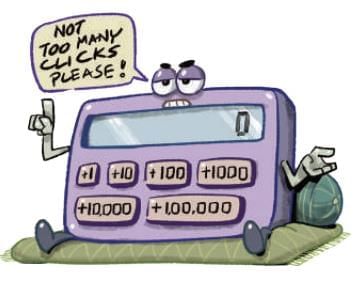
Q2: How can we get the numbers (a) 5072, (b) 8300 using as few button clicks as possible?
(a) 5072
Ans: (5 × 1,000) + (7 × 10) + (2 × 1) = 5,000 + 70 + 2 = 5,072 (14 clicks).
This is minimal as each place value uses the largest possible button.
(b) 8300
Ans: (8 × 1,000) + (3 × 100) = 8,000 + 300 = 8,300 (11 clicks).
This is minimal as each place value uses the largest possible button.
Q3: Find out which buttons should be clicked and how many times to get the desired numbers given in the table. The aim is to click as few buttons as possible. Here is one way to get the number 5072. This method uses 23 button clicks in total. Is there another way to get 5072 using less than 23 button clicks?Write the expression for the same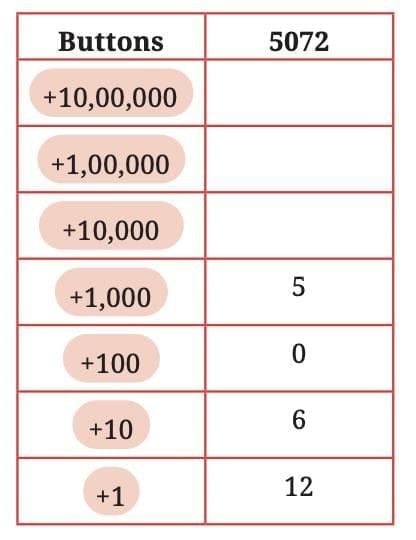
Ans: Minimal method: (5 × 1,000) + (7 × 10) + (2 × 1) = 5,000 + 70 + 2 = 5,072 (14 clicks).
This uses fewer than 23 clicks.
Figure it Out
Q1: For the numbers in the previous exercise, find out how to get each number by making the smallest number of button clicks and write the expression.
(a) 8300
(b) 40629
(c) 56354
(d) 66666
(e) 367813
Ans:
(a) Here, 8300
(8 × 1,000) + (3 × 100) = 8300
Hence, 8300 can be obtained in 8 + 3 = 11 clicks.
(b) Here, 40629
(4 × 10,000) + (6 × 100) + (2 × 10) + (9 × 1) = 40629
Hence, 40629 can be obtained in 4 + 6 + 2 + 9 = 21 clicks.
(c) Here, 56354
(5 × 10,000) + (6 × 1,000) + (3 × 100) + (5 × 10) + (4 × 1) = 56354
Hence, 56354 can be obtained in 5 + 6 + 3 + 5 + 4 = 23 clicks.
(d) Here, 66666
(6 × 10,000) + (6 × 1,000) + (6 × 100) + (6 × 10) + (6 × 1) = 66666
Hence, 66666 can be obtained in 6 + 6 + 6 + 6 + 6 = 30 clicks.
(e) We have 367813
(3 × 1,00,000) + (6 × 10,000) + (7 × 1,000) + (8 × 100) + (1 × 10) + (3 × 1) = 367813
Hence, 367813 can be obtained in 3 + 6 + 7 + 8 + 1 + 3 = 28 clicks.
Q2: Do you see any connection between each number and the corresponding smallest number of button clicks?
Ans: Yes, there is a connection. The smallest number of button clicks = the sum of its digits.
Examples:
5072
Place values: 5 (thousands), 0 (hundreds), 7 (tens), 2 (ones)
Smallest clicks = 5 (+1000) + 7 (+10) + 2 (+1) = 14 clicks8300
Place values: 8 (thousands), 3 (hundreds), 0 (tens), 0 (ones)
Smallest clicks = 8 (+1000) + 3 (+100) = 11 clicks
Q3: If you notice, the expressions for the least button clicks also give the Indian place value notation of the numbers. Think about why this is so.
Ans: Yes, the expressions for the least button clicks reflect the Indian place value notation because:
To minimize button presses, we use the biggest available button for each digit:
+1000for thousands,+100for hundreds,+10for tens,+1for ones.
This is the same as how numbers are written in Indian place value format, where each digit represents a value in its specific place.
Example:
5072 = (5 ×
+1000) + (0 ×+100) + (7 ×+10) + (2 ×+1)
This directly shows the Indian place value: 5000 + 70 + 2
Page No. 8 & 9
Q1: How many zeros does a thousand lakh have?
Ans: Thousand lakh = 1,000 × 1,00,000 = 1,00,00,00,000
It has 8 zeros.
Q2: How many zeros does a hundred thousand have?
Ans: Hundred thousand = 100 × 1,000 = 1,00,000 (same as 1 lakh).
This has 5 zeros.
Figure it Out
Q1: Read the following numbers in Indian place value notation and write their number names in both the Indian and American systems:
(a) 4050678
Ans: Indian: 40,50,678 → Forty lakh fifty thousand six hundred seventy-eight.
American: 4,050,678 → Four million fifty thousand six hundred seventy-eight.
(b) 48121620
Ans: Indian: 4,81,21,620 → Four crore eighty-one lakh twenty-one thousand six hundred twenty.
American: 48,121,620 → Forty-eight million one hundred twenty-one thousand six hundred twenty.
(c) 2,00,22,002
Ans: Indian: 2,00,22,002 → Two crore twenty-two thousand and two.
American: 20,022,002 → Twenty million twenty-two thousand and two.
(d) 246813579
Ans: Indian: 24,68,13,579 → Twenty-four crore sixty-eight lakh thirteen thousand five hundred seventy-nine.
American: 246,813,579 → Two hundred forty-six million eight hundred thirteen thousand five hundred seventy-nine.
(e) 345000543
Ans: Indian: 34,50,00,543 → Thirty-four crore fifty lakh five hundred forty-three.
American: 345,000,543 → Three hundred forty-five million five hundred forty-three.
(f) 1020304050
Ans: Indian: 1,02,03,04,050 → One hundred two crore three lakh four thousand fifty.
American: 1,020,304,050 → One billion twenty million three hundred four thousand fifty.
Q2: Write the following numbers in Indian place value notation:
(a) One crore one lakh one thousand ten
Ans: 1,01,01,010
(b) One billion one million one thousand one
Ans: 1,001,001,001 (1 billion = 100 crore, 1 million = 10 lakh).
(c) Ten crore twenty lakh thirty thousand forty
Ans: 10,20,30,040
(d) Nine billion eighty million seven hundred thousand six hundred
Ans: 9,080,700,600 (9 billion = 900 crore, 80 million = 80 lakh).
Q3: Compare and write '<', '>' or '=':
(a) 30 thousand ______ 3 lakhs
Ans: 30,000 < 3,00,000
∴ 30 thousand ( < ) 3 lakhs.
(b) 500 lakhs ______ 5 million
Ans: 500 lakhs = 5,00,00,000; 5 million = 50,00,000.
5,00,00,000 > 50,00,000
∴ 500 lakhs ( > ) 5 million.
(c) 800 thousand ______ 8 million
Ans: 800,000 < 8,000,000
∴ 800 thousand ( < ) 8 million.
(d) 640 crore ______ 60 billion
Ans: 640 crore = 6,400,000,000 , 60 billion = 60,000,000,000
640 crore < 60 billion
∴ 640 crore ( < ) 60 billion.
Page 10
Q1: Think and share situations where it is appropriate to (a) round up, (b) round down, (c) either rounding up or rounding down is okay and (d) when exact numbers are needed.
Ans: (a) Round up: Ordering food for a party (e.g., 732 people, order 750 sweets to ensure enough).
(b) Round down: Estimating fuel left to drive more carefully.
Estimating remaining time to a meeting (e.g., saying 10 minutes left when it’s 12 minutes) to create urgency and avoid being late.
(c) Either okay: Estimating population for general discussion (e.g., 76,068 as 75,000 or 76,000).
(d) Exact needed: Financial transactions (e.g., paying ₹470 exactly) or scientific measurements.
Page No. 11
Nearest Neighbours
With large numbers it is useful to know the nearest thousand, lakh or crore.
For example, the nearest neighbours of the number 6,72,85,183 are shown in the table below.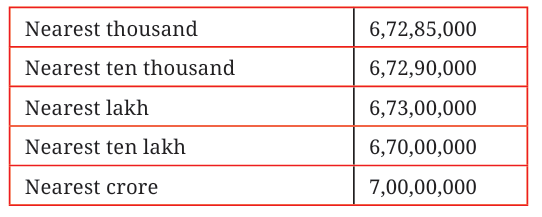
Q1: Similarly, write the five nearest neighbours for these numbers:
(a) 3,87,69,957
Ans: 
(b) 29,05,32,481
Ans:

Q2: I have a number for which all five nearest neighbours are 5,00,00,000. What could the number be? How many such numbers are there?
Ans: The number could be between 4,99,99,501 and 5,00,00,499 as rounding to the nearest thousand, ten thousand, lakh, ten lakh, or crore all yield 5,00,00,000.
There are 1000 such numbers.
Q3: Roxie and Estu are estimating the values of simple expressions.
(1) 4,63,128 + 4,19,682
Roxie: “The sum is near 8,00,000 and is more than 8,00,000.”
Estu: “The sum is near 9,00,000 and is less than 9,00,000.”
(a) Are these estimates correct? Whose estimate is closer to the sum?
Ans: Exact sum = 4,63,128 + 4,19,682 = 8,82,810.
Roxie: Near 8,00,000 and more → Correct (8,82,810 > 8,00,000).
Estu: Near 9,00,000 and less → Correct (8,82,810 < 9,00,000).
Difference: |8,82,810 - 8,00,000| = 82,810; |8,82,810 - 9,00,000| = 17,190.
Estu’s estimate is closer.
(b) Will the sum be greater than 8,50,000 or less than 8,50,000? Why do you think so?
Ans: Yes, it would be more than 8,50,000 because if we add the first 2 digits from left, the sum is 87, which is greater than 85.
(c) Will the sum be greater than 8,83,128 or less than 8,83,128? Why do you think so?
Ans: Sum = 8,82,810 < 8,83,128. The exact sum is slightly less.
(d) Exact value of 4,63,128 + 4,19,682 = ______________
Ans: 8,82,810.
(2) 14,63,128 − 4,90,020
Roxie: “The difference is near 10,00,000 and is less than 10,00,000.”
Estu: “The difference is near 9,00,000 and is more than 9,00,000.”
(a) Are these estimates correct? Whose estimate is closer to the difference?
Ans: Exact difference = 14,63,128 – 4,90,020 = 9,73,108
Estimated difference = 15,00,000 – 5,00,000 = 10,00,000.
The exact difference is 9,73,108, which is closer to 10,00,000.
Therefore, Roxie’s estimate is correct and closer to the difference.
(b) Will the difference be greater than 9,50,000 or less than 9,50,000? Why do you think so?
Ans: Estimating the given two numbers to the nearest ten thousand,
14,63,128 → 14,60,000
4,90,020 → 4,90,000
Difference = 14,60,000 – 4,90,000 = 9,70,000, which is greater than 9,50,000.
(c) Will the difference be greater than 9,63,128 or less than 9,63,128? Why do you think so?
Ans: Difference = 9,73,108 > 9,63,128. The exact difference is slightly more.
(d) Exact value of 14,63,128 − 4,90,020 = _______________
Ans: 9,73,108.
Page No. 13
Observe the populations of some Indian cities in the table below.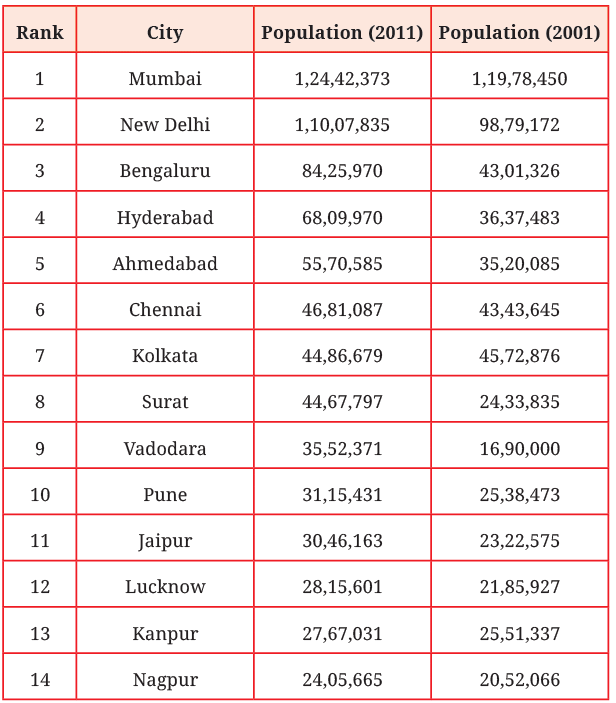
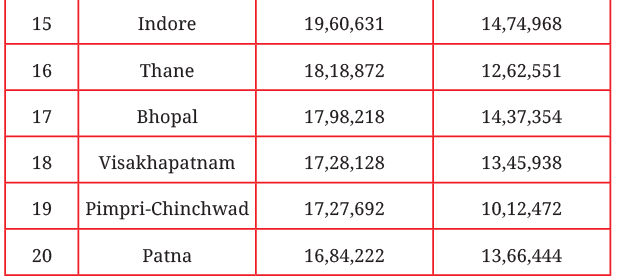
From the information given in the table, answer the following questions by approximation:
Q1: What is your general observation about this data? Share it with the class.
Ans: The population of most cities increased from 2001 to 2011. Some cities like Bengaluru and Hyderabad grew a lot, while others like Kolkata grew less or decreased.
Q2: What is an appropriate title for the above table?
Ans: “Population Growth of Major Indian Cities (2001 and 2011)”.
Q3: How much is the population of Pune in 2011? Approximately, by how much has it increased compared to 2001?
Ans: Pune’s population in 2011 = 31,15,431.
Pune’s population in 2001 = 25,38,473.
Increase in population = 3,115,431 – 2,538,473 = 576,958.
Approximately, the population increased by about 5.8 lakhs or nearly 6 lakhs.
Q4: Which city’s population increased the most between 2001 and 2011?
Ans: Population increase of some cities:
Bengaluru: 84,25,970 – 43,01,326 = 41,24,644
Hyderabad: 68,09,970 – 36,37,483 = 31,72,487
Ahmedabad: 55,70,585 – 35,20,085 = 20,50,500
Surat: 44,67,797 – 24,33,835 = 20,33,962
Vadodara: 35,52,371 – 16,90,000 = 18,62,371
Bengaluru had the highest population increase: 41,24,644.
Q5: Are there cities whose population has almost doubled? Which are they?
Ans: Yes, several cities nearly doubled their population. They are:
(i) Bengaluru
2001: 43,01,326 → 43,00,000
2011: 84,25,970 → 84,00,000
(ii) Hyderabad
2001: 36,37,483 → 36,00,000
2011: 68,09,970 → 68,00,000
(iii) Surat
2001: 24,33,835 → 24,00,000
2011: 44,67,797 → 45,00,000
(iv) Vadodara
2001: 16,90,000 → 17,00,000
2011: 35,52,371 → 36,00,000
These rounded figures show that each of these cities experienced close to a two-fold population increase over the decade.
Q6: By what number should we multiply Patna’s population to get a number/population close to that of Mumbai?
Ans: Patna 2011: 16,84,222.
Mumbai 2011: 1,24,42,373. Hence, we should multiply Patna’s population by approx 7.4 to get a number close to that of Mumbai.
Hence, we should multiply Patna’s population by approx 7.4 to get a number close to that of Mumbai.
Page No. 14
Roxie and Estu are playing with multiplication. They encounter an interesting technique for multiplying a number by 10, 100, 1000, and so on.
Roxie evaluated 116 × 5 as follows: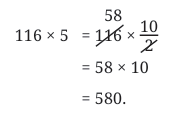
Estu evaluated 824 × 25 as follows:
Q: Using the meaning of multiplication and division, can you explain why multiplying by 5 is the same as dividing by 2 and multiplying by 10?
Ans: We know that 5 × 2 = 10 (multiplication fact) has two division facts: 10 ÷ 2 = 5 and 10 ÷ 5 = 2.
So, according to the question, we can use 10/2 in place of 5. Either we 10
divide by 5 or by 10/2, we will get the same answer.
Figure it Out
Q1: Find quick ways to calculate these products:
(a) 2 × 1768 × 50
Ans: First, multiply 2 × 50 = 100. Then, multiply 100 × 1768 = 1,76,800.
So, 2 × 1768 × 50 = 1,76,800.
(b) 72 × 125 [Hint: 125 = 1000 ÷ 8]
Ans: Use the hint: 125 = 1000 ÷ 8.
So, First, 72 × 1000 = 72000.
First, 72 × 1000 = 72000.
Then, 72000 ÷ 8 = 9000.
Therefore, 72 × 125 = 9000.
(c) 125 × 40 × 8 × 25
Ans: First, group the numbers: (125 × 8) × (40 × 25).
125 × 8 = 1000, and 40 × 25 = 1000.
Then, 1,000 × 10,00 = 10,00,000.
So, 125 × 40 × 8 × 25 = 10,00,000.
Q2: Calculate these products quickly.
(a) 25 × 12 = ______
Ans: Here,
(b) 25 × 240 = ______
Ans: Here,
(c) 250 × 120 = ______
Ans: Here,
(d) 2500 × 12 = ______
Ans: Here,
(e) ______ × ______ = 120000000
Ans: 
How Long is the Product?
Q3: In each of the following boxes, the multiplications produce interesting patterns. Evaluate them to find the pattern. Extend the multiplications based on the observed pattern.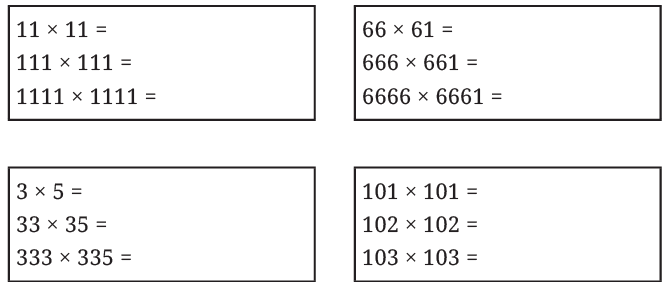 Ans:
Ans: 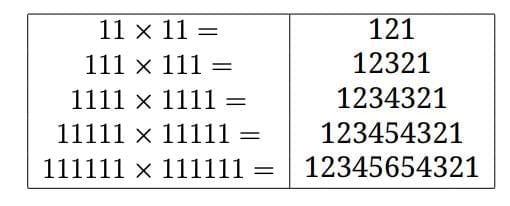
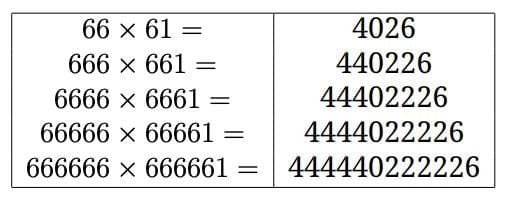
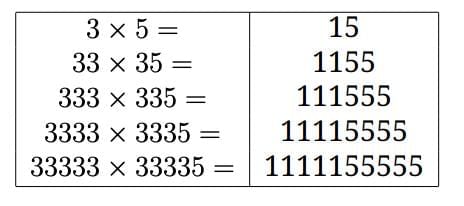
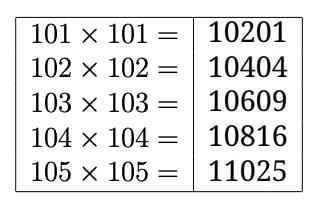
Page No. 15
Q4: Observe the number of digits in the two numbers being multiplied and their product in each case. Is there any connection between the numbers being multiplied and the number of digits in their product?
Ans: Box 1 Repeating 1s:
- 11 × 11 → 2-digit × 2-digit → product: 121 (3 digits)
- 111 × 111 → 3-digit × 3-digit → product: 12321 (5 digits)
- 1111 × 1111 → 4-digit × 4-digit → product: 1234321 (7 digits)
We observe that the product has (2n-1) digits when n-digit numbers of repeating 1s are multiplied.
Box 2 Repeating with 6s and 1:
- 66 × 61 → 2-digit × 2-digit → product: 4026 (4 digits)
- 666 × 661 → 3-digit × 3-digit → product: 440226 (6 digits)
- 6666 × 6661 → 4-digit × 4-digit → product: 44402226 (8 digits)
We observe that the product has (n + n) = 2n digits, where n is the number of 6s in first term.
Box 3 Repeating 3s and 5:
- 3 × 5 → 1-digit × 1-digit → 15 (2 digits)
- 33 × 35 → 2-digit × 2-digit → product: 1155 (4 digits)
- 333 × 335 → 3-digit × 3-digit → product: 111555 (6 digits)
We observe that the product has 2n digits, where n is the number of 3s in first term.
e.g. 3-digit numbers → 6-digit product
Box 4 Squares of numbers just above 100:
- 101 × 101 = 10201 (5 digits)
- 102 × 102 = 10404 (5 digits)
- 103 × 103 = 10609 (5 digits)
We observe that multiplying two same numbers just over 100 gives a 5-digit product.
Q5: Roxie says that the product of two 2-digit numbers can only be a 3- or a 4-digit number. Is she correct?
Ans: Yes. Smallest product: (3 digits).
Largest product: (4 digits).
All products are either 3 or 4 digits.
Q6: Should we try all possible multiplications with 2-digit numbers to tell whether Roxie’s claim is true? Or is there a better way to find out?
Ans: There is no need to try all possible multiplications to verify Roxie’s claim.
A better way is given in the examples below.
10 × 10 = 100 (3-digit), 10 being the smallest 2-digit number
99 × 99 = 9801 (4-digit), 99 being the largest 2-digit number
Q7: Can multiplying a 3-digit number with another 3-digit number give a 4-digit number?
Ans: No. Smallest 3 digit numbers when multiplied with each
Product of smallest two 3-digit numbers = 100 × 100 = 10,000 (5-digit number)
Product of largest two 3-digit numbers = 999 × 999 = 9,98,001 (6-digit number)
Hence, a 4-digit number can’t be obtained by multiplying two 3-digit numbers.
Q8: Can multiplying a 4-digit number with a 2-digit number give a 5-digit number?
Ans: Here, product of smallest 4-digit number and a 2-digit number = 1,000 × 10 = 10,000 (4-digit number)
and product of largest 4-digit number and a 2-digit number = 9,999 × 99 = 9,89,901 (5-digit number)
Yes, it is possible.
Q9: Observe the multiplication statements below. Do you notice any patterns? See if this pattern extends for other numbers as well.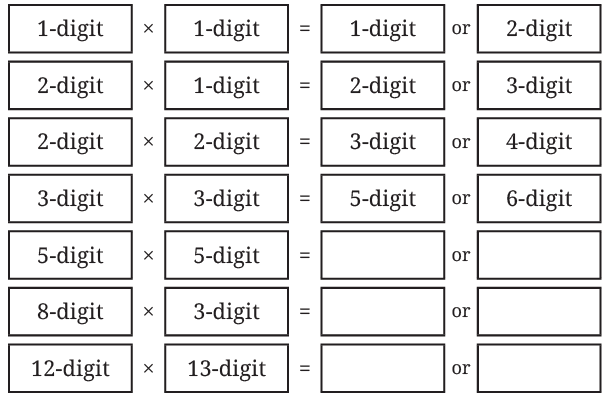 Ans:
Ans: 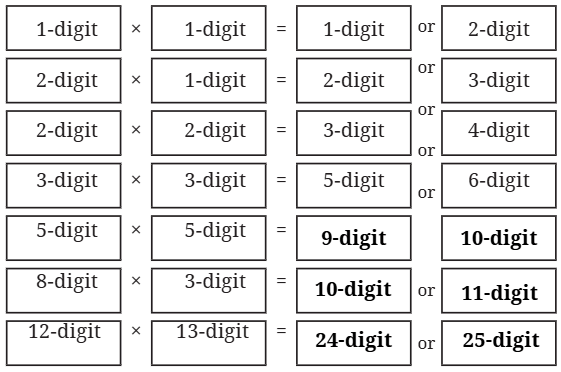
Page No. 16
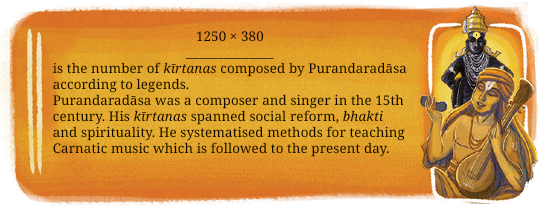
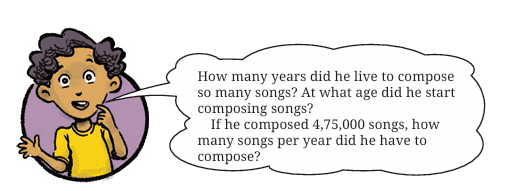 Ans: Kirtanas = 1250 × 380
Ans: Kirtanas = 1250 × 380
First, break it down:
= (125 × 10) × (38 × 10)
= 125 × 38 × 10 × 10
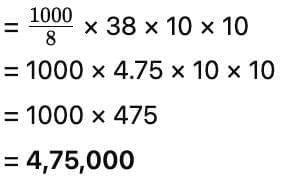
Let’s assume this:
He lived for 95 years
He started composing songs at age 25
So, number of composing years = 95 − 25 = 70 years
He composed 4,75,000 songs in 70 years
4,75,000 ÷ 70 = 6785.71 songs per year (approx.)
So, he composed about 6,786 songs every year!
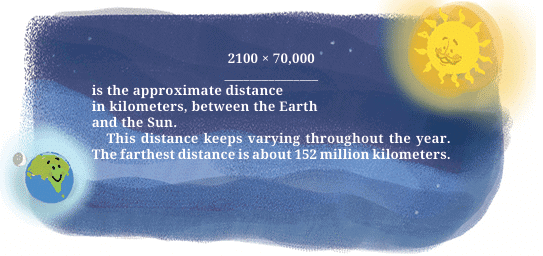 Distance = 2100 × 70,000
Distance = 2100 × 70,000
= (21 × 1,000) × (7 × 10,000)
= 21 × 7 × 1,000 × 10,000
= 147 × 1,00,00,000
= 1,47,00,00,000 km
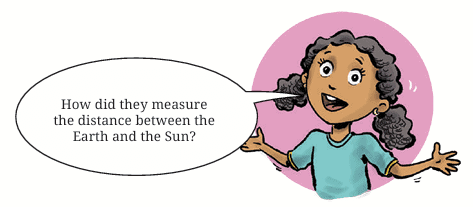 Ans: Scientists cannot use a tape measure to find how far the Sun is! Instead, they used smart methods and mathematics:
Ans: Scientists cannot use a tape measure to find how far the Sun is! Instead, they used smart methods and mathematics:
1. Astronomical Unit (AU):
One AU is the average distance between the Earth and the Sun.
1 AU = 150 million kilometres.
2. Parallax Method:
Scientists looked at the Sun or planets from two different places on Earth and measured the slight shift in position (called parallax). Using triangle math, they calculated the distance.
3. Radio Signals from Spacecraft:
Spacecraft sent signals back to Earth. By measuring the time it took for the signal to return and knowing the speed of light, scientists found the distance.
Page No. 17
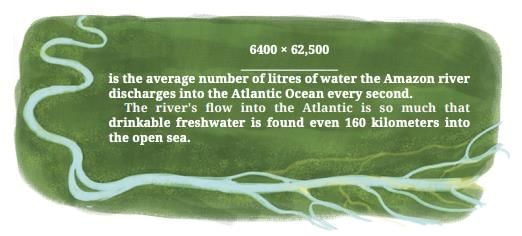
Required Average = 6,400 × 62,500
= (64 × 100) × (625 × 100)
= 64 × 625 × 100 × 100
= 40,000 × 10,000
= 40,00,00,000 litres
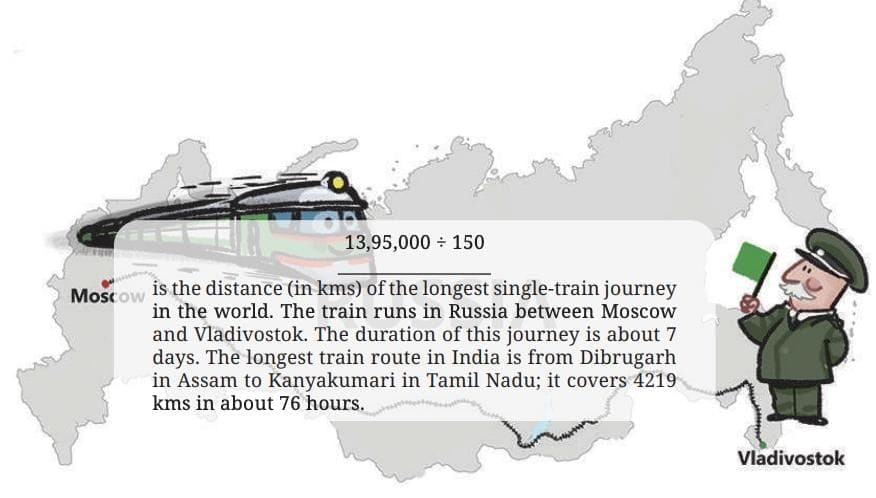
Ans: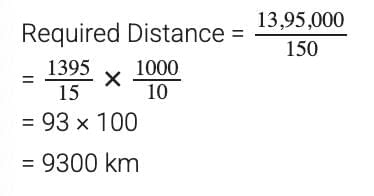
Page No. 18
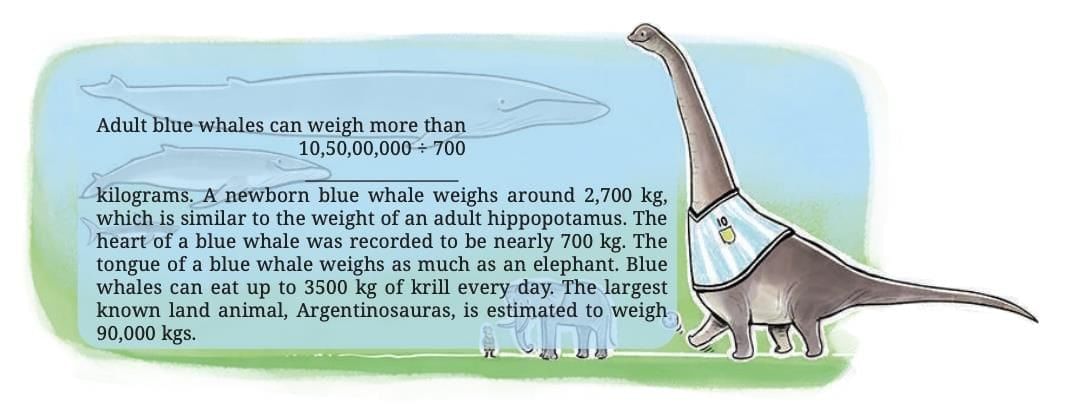
Ans: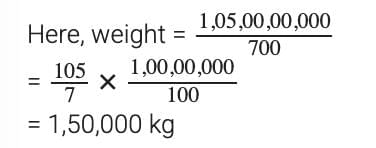
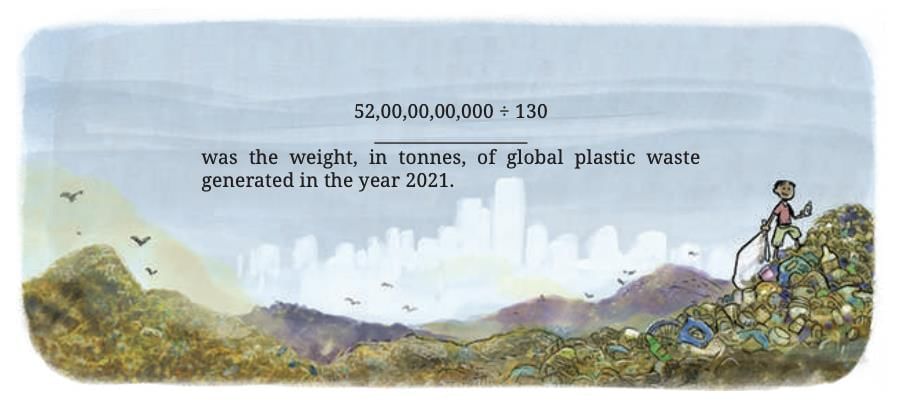
Ans:
Page No. 19
Q1: The RMS Titanic ship carried about 2500 passengers. Can the population of Mumbai fit into 5000 such ships? Ans: Population of Mumbai = 1,24,00,000
Ans: Population of Mumbai = 1,24,00,000
Here, passengers in one ship = 2500
and passengers in 5000 ships = 5000 × 2500 = 1,25,00,000.
1,24,42,373 < 1,25,00,000.
Hence, the population of Mumbai can easily fit into 5000 such ships.
Q2: Inspired by this strange question, Roxie wondered, “If I could travel 100 kilometers every day, could I reach the Moon in 10 years?” (The distance between the Earth and the Moon is 3,84,400 km.)
How far would she have travelled in a year?
Ans: Distance travelled by Roxie in a year = 100 km/day × 365 days = 36,500 km
How far would she have travelled in 10 years?
Ans: Distance travelled by Roxie in 10 years = 100 km/day × 365 days × 10
= 36500 km × 10
= 3,65,000 km
Is it not easier to perform these calculations in stages? You can use this method for all large calculations.
Ans: Yes, it is easier to perform these calculations in stages.
Q3: Find out if you can reach the Sun in a lifetime, if you travel 1000 kilometers every day. (You had written down the distance between the Earth and the Sun in a previous exercise.)
Ans: Distance between the Earth and the Sun = 2100 × 70,000 = 147000000 km
Distance travelled by you = 1000 km/day
Time required = 147000000 km ÷ 1000 km/day
= 147000 days
= 147000 days ÷ 365 days/year
~ 403 years
Not possible, as an average human being has a life expectancy of less than 100 years.
Q4: Make necessary reasonable assumptions and answer the questions below:
(a) If a single sheet of paper weighs 5 grams, could you lift one lakh sheets of paper together at the same time?
Ans: Here, the weight of a single sheet = 5 grams
Weight of 1 lakh sheets = 1,00,000 × 5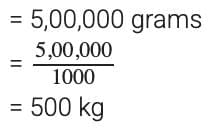
Average person can lift ~50 kg. 500 kg is too heavy, so no, you cannot lift it.
(b) If 250 babies are born every minute across the world, will a million babies be born in a day?
Ans: Babies born in an hour = 250 × 60 = 15,000 babies
Babies born in a day = 15,000 × 24 = 3,60,000 babies
Now, 3,60,000 is less than 1 million (10 lakh).
Hence, a million babies will not be born in a year.
(c) Can you count 1 million coins in a day? Assume you can count 1 coin every second.
Ans: Here, coins counted per sec = 1 coin
Coins counted per minute = 60 coins
Coins counted per hour = 60 × 60 = 3,600 coins
Coins counted per day = 3,600 × 24 = 86,400 coins
Since 84,000 is much less than 1 million (10 lakh).
Hence, you can’t count 1 million coins in a day.
Page No. 19
Figure it Out
Q1: Using all digits from 0 – 9 exactly once (the first digit cannot be 0) to create a 10-digit number, write the —
(a) Largest multiple of 5
Ans: Arranging digits in decreasing order = 9,8,7,6,5,4,3,2,1,0
All multiples of 5 can end only in 5 or 0.
∴ Largest multiple of 5 = 9876543210.
(b) Smallest even number
Ans: Arranging digits in ascending order = 0,1,2,3,4,5,6,7,8,9
Since, number can’t start with zero. So, the smallest number = 1023456789
Swapping the last two digits to make the above number even.
∴ Smallest even number = 1023456798
Q2: The number 10,30,285 in words is Ten lakhs thirty thousand two hundred eighty five, which has 43 letters. Give a 7-digit number name which has the maximum number of letters.
Ans: Using 7 (seven) and 8 (eight) to make such a number since both numbers contain 5 letters when written in words.
77,77,777 = Seventy-seven lakh seventy-seven thousand seven hundred seventy-seven.
Letters in 77,77,777 = 60.
88,88,888 = Eighty-eight lakh eighty-eight thousand eight hundred eighty-eight.
Letters in 88,88,888 = 57.
Hence, 77,77,777 has the maximum number of letters in its number name.
Q3: Write a 9-digit number where exchanging any two digits results in a bigger number. How many such numbers exist?
Ans: A 9-digit number where exchanging any two digits results in a bigger number = 987654321. Only one such number exists.
Q4: Strike out 10 digits from the number 12345123451234512345 so that the remaining number is as large as possible.
Ans: We have 20 digits and need to strike out 10, leaving us with 10 digits. To maximize the resulting number,
1. Only strike out the first four digits (1234), the remaining number starts with ‘ 5 ’.
2. Continue the process: Now our number starts with ‘5 ’. We’ve struck out 4 digits so far and need to strike out 6 more. The remaining number is 5123451234512345.
We want the next digit to be as large as possible. We can strike out the ‘1234’ following the ‘5’, leaving us with 551234512345.
We’ve now struck out 4 + 4 = 8 digits.
3. We need to strike out two more digits from 551234512345. To keep the number as large as possible, we should strike out the ‘1’ and the ‘2’.
Therefore, by striking out the digits 1234, then 1234, then 1, then 2, the remaining number is 5,53,45,12,345.
Q5: The words ‘zero’ and ‘one’ share letters ‘e’ and ‘o’. The words ‘one’ and ‘two’ share a letter ‘o’, and the words ‘two’ and ‘three’ also share a letter ‘t’. How far do you have to count to find two consecutive numbers which do not share an English letter in common?
Ans: The problem involves finding two consecutive numbers whose English names share no common letters.
Here, zero and one share “e” and “o”.
one (1) and two (2) share “o”.
two (2) and three (3) share “t”.
……………………………..
Nineteen and twenty share: ‘t’, ‘e’, ‘n’
…………….. and so on.
Therefore, there are no consecutive numbers that do not share a letter in common.
Q6: Suppose you write down all the numbers 1, 2, 3, 4, …, 9, 10, 11, ... The tenth digit you write is ‘1’ and the eleventh digit is ‘0’, as part of the number 10.
(a) What would the 1000th digit be? At which number would it occur?
Ans: Here, digits from 1 to 9 = 9 digits
Digits from 10 to 99 = 90 numbers × 2 = 180 digits
Total digits from 1 to 99 = 180 + 9 = 189 digits
Remaining digits to reach 1000th digit = 1000 – 189 = 811 full numbers + 1 digit left over.
full numbers + 1 digit left over.
The first 3-digit number is 100
270th 3 digit number is 100 + 270 – 1 = 369
The next number is 370.
Hence, the first digit of 370, which is 3, is the 1000th digit.
(b) What number would contain the millionth digit?
Ans:
Numbers 1-9: 9 digits
Numbers 10-99: 180 digits
Numbers 100-999: 2700 digits
Numbers 1000-9999: 9000 × 4 = 36,000 digits
Numbers 10,000-99,999: 90,000 × 5 = 4,50,000 digits
Numbers 1,00,000-9,99,999: 9,00,000 × 6 = 54,00,000 digits
To reach the millionth digit:
Upto 5-digit numbers: 9 + 180 + 2700 + 36,000 + 4,50,000 = 4,88,889
Remaining digits in the 6-digit range: 1,000,000 (or (10,00,000) – 4,88,889 = 5,11,111
The number of 6-digit numbers required: 5,11,111 ÷ 6 = 85,185, with 1 remaining number.
So, the 85,185th 6-digit number is 85,185 + 1,00,000 – 1 = 1,85,184.
The millionth digit occurs in the number 185184 + 1 = 1,85,185.
(c) When would you have written the digit ‘5’ for the 5000th time?
Ans: We count how many times the digit 5 appears while writing the numbers in order.
1) 1 to 9:
Only “5” → 1 time.
Cumulative = 1.
2) 10 to 99 (two-digit):
- Tens place: 50–59 → 10 times
- Ones place: 15, 25, …, 95 → 9 times
Total = 19.
Cumulative to 99 = 1 + 19 = 20.
3) 100 to 999 (three-digit):
- Hundreds place: 500–599 → 100
- Tens place: in each 100-block (x00–x99), 10 numbers have tens = 5 → 9 blocks → 90
- Ones place: similarly 90
Total = 280.
Cumulative to 999 = 20 + 280 = 300.
4) 1000 to 9999 (four-digit):
- Thousands: 5000–5999 → 1000
- Hundreds: 9 blocks × 100 each → 900
- Tens: 900
- Ones: 900
Total = 3700.
Cumulative to 9999 = 300 + 3700 = 4000.
We still need 5000 − 4000 = 1000 more 5’s.
5) 10000 to 12999:
In each block of 1000 numbers, the last three digits run 000–999, so 5 appears
100 times in hundreds + 100 in tens + 100 in ones = 300 per block.
Three blocks (10000–10999, 11000–11999, 12000–12999) → 900.
Cumulative to 12999 = 4000 + 900 = 4900.
We still need 100 more 5’s.
6) 13000 to 13499 (500 numbers):
- Hundreds digit is never 5 here → 0
- Tens digit = 5 occurs 10 per 100, across 5 hundreds → 50
- Ones digit = 5 occurs 10 per 100, across 5 hundreds → 50
Total = 100.
So we reach the 5000th ‘5’ at the end of 13499.
The last ‘5’ before 13500 is at 13,495 (units place).
Q7: A calculator has only ‘+10,000’ and ‘+100’ buttons. Write an expression describing the number of button clicks to be made for the following numbers:
(a) 20,800
Ans: 20,800 = 2 × 10,000 + 8 × 100
Number of clicks = 2 + 8 = 10 clicks
(b) 92,100
Ans: 92,100 = 9 × 10,000 + 21 × 100
Number of clicks = 9 + 21 = 30 clicks
(c) 1,20,500
Ans: 1,20,500 = 12 × 10,000 + 5 × 100
Number of clicks = 12 + 5 = 17 clicks
(d) 65,30,000
Ans: 65,30,000 = 653 × 10,000 + 0 × 100
Number of clicks = 653 + 0 = 653 clicks
(e) 70,25,700
Ans: 70,25,700 = 702 × 10,000 + 57 × 100
Number of clicks = 702 + 57 = 759 clicks
Q8: How many lakhs make a billion?
Ans: 
Q9: You are given two sets of number cards numbered from 1 – 9. Place a number card in each box below to get the (a) largest possible sum (b) smallest possible difference of the two resulting numbers.
Ans:
(a) To get the largest possible sum, both the 7-digit and 5-digit numbers need to be the largest.
7-digit number = 98,76,543
5-digit number = 98,765
Longest possible sum = 98,76,543 + 98,765 = 99,75,308
(b) To get the smallest possible difference, the 7-digit number needs to be the smallest, and the 5-digit number needs to be the largest.
7-digit number = 12,34,567
5-digit number = 98,765
Smallest possible difference = 12,34,567 − 98,765 = 11,35,802
Page No. 21
Q10: You are given some number cards: 4000, 13000, 300, 70000, 150000, 20, 5. Using the cards get as close as you can to the numbers below using any operation you want. Each card can be used only once for making a particular number.
(a) 1,10,000
Ans: Closest estimate = 70,000 + (4,000 × 5) + 13,000
= 70,000 + 20,000 + 13,000
= 1,03,000
(b) 2,00,000:
Ans: Closest estimate = 1,50,000 + 70,000 – 4,000 × 5
= 1,50,000 + 70,000 – 20,000
= 2,00,000
(c) 5,80,000:
Ans: Closest estimate = 70,000 × 5 + 1,50,000 + 4,000 × 20
= 3,50,000 + 1,50,000 + 80,000
= 5,80,000
(d) 12,45,000
Ans: Closest estimate = 70,000 × 20 – 1,50,000 – 4,000 – 300 × 5
= 14,00,000 – 1,50,000 – 4,000 – 1,500
= 12,44,500
It is very close to 12,45,000
(e) 20,90,800
Ans: Closest estimate = 13,000 × 300 – 70,000 (20 + 5) – 1,50,000 + 4,000
= 39,00,000 – 17,50,000
= 20,04,000.
Q11: Find out how many coins should be stacked to match the height of the Statue of Unity. Assume each coin is 1 mm thick.
Ans: Height of each coin = 1 mm
Height of Statue of Unity = 180 m = 180 × 100 × 10 mm = 1,80,000 mm.
Number of coins to be stacked = (1,80,000 mm)/(1 mm) = 1,80,000 coins.
Q12: Grey-headed albatrosses have a roughly 7-feet wide wingspan. They are known to migrate across several oceans. Albatrosses can cover about 900 – 1000 km in a day. One of the longest single trips recorded is about 12,000 km. How many days would such a trip take to cross the Pacific Ocean approximately?
Ans: Distance = 12,000 km. Speed = 950 km/day (average).
Days = 12,000 ÷ 950 ≈ 12.63.
Approximately 13 days.
Here, total trip = 12,000 km
Distance covered in a day = 900 – 1000 km
Estimated Number of days if it flies 900 km/day = Estimated Number of days if it fies 1000 km/day =
Estimated Number of days if it fies 1000 km/day =
Hence, it would take approximately 12 to 14 days for a grey-headed albatross to complete a 12,000 km trip across the Pacific Ocean.
Q13: A bar-tailed godwit holds the record for the longest recorded non-stop flight. It travelled 13,560 km from Alaska to Australia without stopping. Its journey started on 13 October 2022 and continued for about 11 days. Find out the approximate distance it covered every day. Find out the approximate distance it covered every hour.
Ans: Here, total distance = 13,560 km
Duration = 11 days; Each day = 24 hours
Duration in hours =11 × 24 = 264 hours
Hence, distance covered per day = (13,560 km)/(11 days) = 1232.73 km or ≈ 1233 km.
Hence, distance covered per hour = (13,560 km)/(264 hours) = 51.36 km or ≈ 51 km.
Q14: Bald eagles are known to fly as high as 4500 – 6000 m above the ground level. Mount Everest is about 8850 m high. Aeroplanes can fly as high as 10,000 – 12,800 m. How many times bigger are these heights compared to Somu’s building?
Ans: Let’s compare these heights to Somu’s building:
Bald eagle: 4500 – 6000 m;
Mount Everest: 8850 m;
Aeroplanes: 10,000 – 12,800 m
Somu’s building is 44 m tall.
Ratios compared to Somu’s building:
Bald eagle:  to
to  The bald eagle’s flying height is 100 – 150 times higher. Mount Everest:
The bald eagle’s flying height is 100 – 150 times higher. Mount Everest:  Mount Everest is 201 times bigger.
Mount Everest is 201 times bigger.
Aeroplanes: An aeroplane’s flying height is 230 – 290 times higher.
An aeroplane’s flying height is 230 – 290 times higher.
|
41 videos|251 docs|8 tests
|
FAQs on NCERT Solutions for Class 7 Maths Chapter 1 Large Numbers Around Us
| 1. What are large numbers and why are they important in our daily lives? |  |
| 2. How can we represent large numbers effectively? |  |
| 3. What are some examples of large numbers in real-world contexts? |  |
| 4. How do we read and write large numbers correctly? |  |
| 5. Why is it important for students to learn about large numbers in mathematics? |  |






















